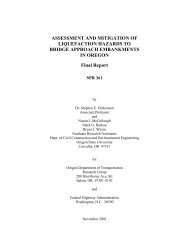Oregon Balance of State HIV/AIDS Housing & Services Systems ...
Oregon Balance of State HIV/AIDS Housing & Services Systems ...
Oregon Balance of State HIV/AIDS Housing & Services Systems ...
Create successful ePaper yourself
Turn your PDF publications into a flip-book with our unique Google optimized e-Paper software.
<strong>Oregon</strong> <strong>HIV</strong>/<strong>AIDS</strong> <strong>Housing</strong> and <strong>Services</strong> <strong>Systems</strong> Integration Plan—Appendices A-51<br />
construction, and tenant-based rental assistance. Assistance can take the form <strong>of</strong> loans, advances, equity<br />
investments, interest subsidies, and others. A portion (at least 15 percent) <strong>of</strong> HOME funds must be set aside<br />
for community housing development organizations (CHDOs), which are nonpr<strong>of</strong>it organizations that meet<br />
certain HUD-established criteria.<br />
<strong>Housing</strong> Opportunities for Persons with <strong>AIDS</strong> (HOPWA)<br />
http://www.hud.gov/<strong>of</strong>fices/cpd/aidshousing/programs/<br />
The HOPWA program is also part <strong>of</strong> the Consolidated Plan process. HOPWA provides grant funds to state<br />
and local governments to design long-term, comprehensive strategies for meeting the housing needs <strong>of</strong> lowincome<br />
people living with <strong>HIV</strong>/<strong>AIDS</strong> and their families. Participating jurisdictions have the flexibility to<br />
create a range <strong>of</strong> housing programs, including housing information services, resource identification, project-<br />
or tenant-based rental assistance, short-term rent, mortgage, and utility payments to prevent homelessness,<br />
development and housing operations, and support services. Ninety percent <strong>of</strong> HOPWA funds are awarded<br />
through formula entitlement grants, and the remaining 10 percent are awarded through a competitive grant<br />
program.<br />
HOPWA Formula Grants<br />
HUD awards 75 percent <strong>of</strong> HOPWA Formula Grant funds to eligible states and qualifying cities. Eligibility<br />
is based on the number <strong>of</strong> cases <strong>of</strong> <strong>AIDS</strong> reported by the Centers for Disease Control and Prevention as <strong>of</strong><br />
March 31 <strong>of</strong> the year prior to the appropriation. Eligible metropolitan statistical areas (EMSAs) and states<br />
receive direct allocations <strong>of</strong> HOPWA funding when 1,500 cumulative cases <strong>of</strong> <strong>AIDS</strong> are diagnosed in a<br />
region. The remaining 25 percent <strong>of</strong> funds is allocated among metropolitan areas that have had a higher than<br />
average per capita incidence <strong>of</strong> <strong>AIDS</strong>.<br />
HOPWA formula entitlement grantees may carry out eligible programs themselves, deliver them through any<br />
<strong>of</strong> their administrative entities, select or competitively solicit project sponsors, and/or contract with service<br />
providers.<br />
HOPWA Competitive Grants<br />
Competitive grants are awarded in the following categories:<br />
• Special Projects <strong>of</strong> National Significance (SPNS). Because <strong>of</strong> their innovation or ability to be<br />
replicated, these projects are intended to be models for addressing the needs <strong>of</strong> low-income people<br />
living with <strong>HIV</strong>/<strong>AIDS</strong> and their families.<br />
• Long-Term Comprehensive Strategies for Providing <strong>Housing</strong> and Related <strong>Services</strong>.<br />
Applications in this category can be submitted by state or local governments that are not eligible for<br />
HOPWA formula allocations during that fiscal year.<br />
HUD Homeless Assistance Continuum <strong>of</strong> Care<br />
In order to encourage the integration and coordination <strong>of</strong> community homeless assistance, HUD’s primary<br />
homeless assistance programs—Supportive <strong>Housing</strong> Program, Shelter Plus Care, Emergency Shelter Grants<br />
(ESG – which is also included in the Consolidated Plan), and Single Room Occupancy Program (formerly<br />
Section 8 SRO Mod. Rehab.)—are combined under the Continuum <strong>of</strong> Care planning and allocation process.<br />
The Continuum <strong>of</strong> Care system includes four components: outreach to and needs assessment <strong>of</strong> individuals<br />
or families who are homeless, emergency shelters with supportive services, transitional housing with support<br />
services, and permanent independent or supportive housing to meet long-term needs. The establishment <strong>of</strong> a<br />
Continuum <strong>of</strong> Care system involves a community-wide or region-wide process involving nonpr<strong>of</strong>it

















